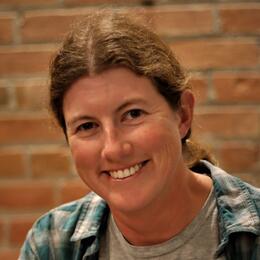Another entry in Abby’s Birdbrained Summer. Abby, the summer communication intern for the Coast Office of Audubon North Carolina, is visiting sites with Audubon’s field staff and our community of volunteers. After she goes into the field, she’ll post blogs detailing her experiences.
Last week, I got off of work and received a voicemail from Lindsay, Audubon North Carolina’s coastal biologist. “As of about 3:30, we have made a plan to go out and catch the last oystercatcher for the tracking project,” she said. We were capturing the oystercatcher in order to put a satellite transmitter on its back for the American Oystercatcher Tracking Project. The American Oystercatcher Tracking Project will use six oystercatchers’ satellite transmissions to “learn more about their movements and habitat use, helping conservation efforts.”
The next morning, the crew assembled at Lea-Hutaff Island. The team was composed of Ted Simons, a professor at North Carolina State University and an oystercatcher-catching professional; Lindsay, the coastal biologist; Walker, Audubon North Carolina's deputy director; and Tara, Lea-Hutaff's bio tech. It is quite difficult to capture an adult American Oystercatcher. Lindsay and Ted have been traveling up and down the North Carolina coast since late spring to capture birds for the project. They caught some birds successfully, but a bird on Lea-Hutaff had previously eluded them. Capture relies on triggering the oystercatchers' impulse to defend their territories. As summer elapses, they get less territorial due to hormone changes linked to the day length, making it even more difficult to catch them.
Our tactic for capturing the oystercatcher on Lea-Hutaff was laying noose carpet around the nest. Noose carpet is a simple contraption: just nooses made of fishing line tied to a metal frame. We found the oystercatcher’s nest and surrounded it with three frames of noose carpet. Then we covered the metal frame in sand so the nooses were upright. Ted put an incredibly realistic oystercatcher decoy near the nest and a sound box that emitted oystercatcher piping calls. The plan was for the oystercatcher to return to its nest, only to see another bird encroaching on its territory. Theoretically, it would rush the decoy and get trapped in the noose carpet.
We retreated and the first of the oystercatcher pair swiftly returned. The bird was incredibly hesitant, and paced around the noose carpet for about ten minutes. Luckily, it was a cool day, so the eggs were not threatened by hot sand and sun. Eventually, its mate returned. The mate had orange and green bands on its legs. The two mates piped at the decoy and did a strange dance, involving aggressively bobbing their heads in a choreographed motion. Of course, the decoy was not intimidated. The birds grew frustrated, and at long last approached the decoy. The oystercatcher with orange and green bands was trapped in the noose carpet.
When we saw the bird was trapped, Ted ran and grabbed it to take the noose off of its leg. Thanks to the bird’s identifying band, we know he was originally banded in 2002 in Georgia, which is pretty old! We named him Orange Green for the remaining bands on his legs. Since the orange and green bands that he was named for were not unique, we replaced them with solid green bands reading CJL. The plastic bands were sealed with blue plumber’s glue. Then, Lindsay and Ted equipped Orange Green with the satellite transmitter. The transmitter was fit onto the bird with straps resembling a backpack. Its feet went through the loops so the transmitter was situated snugly to its back, with an antenna extending past its tail feathers.
After Orange Green was wearing the satellite transmitter, we put him in a blind for a few minutes. The dark tent helped calm Orange Green by reducing sensory input. We could see that he was walking normally and otherwise adjusting to the new harness. When the bird was calm, Ted and Lindsay removed him from the blind and made sure that the satellite transmitter was secure. Then, less than an hour after his capture, we released Orange Green. He took off over the Atlantic, but soon returned to his nest.
If you want to keep up with Orange Green, please visit www.oystercatchertracking.org!




